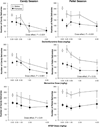Antagonism of glutamatergic NMDA and mGluR5 receptors decreases consumption of food in baboon model of binge-eating disorder
- PMID: 18573641
- PMCID: PMC2591926
- DOI: 10.1016/j.euroneuro.2008.05.004
Antagonism of glutamatergic NMDA and mGluR5 receptors decreases consumption of food in baboon model of binge-eating disorder
Abstract
Excessive consumption of highly palatable foods may contribute to the development of weight gain. Therefore medications that selectively suppress eating of such foods would be useful in clinical practice. We compared the effects of the glutamatergic antagonists memantine and MTEP to dexfenfluramine in baboons given periodic access to highly palatable food and ad libitum access to a standard chow diet. Three days a week baboons received a sugar-coated candy during the first meal and standard standard-diet chow pellets were available in subsequent meals. All baboons derived a greater amount of energy from the single single-candy meal than from the standard diet across an entire day. Pre-treatment with dexfenfluramine, memantine, and MTEP produced decreases in candy consumption without altering candy-seeking behaviour. At the same time, dexfenfluramine and memantine, but not MTEP, produced a decrease in seeking and consumption of standard chow pellets. Both memantine and MTEP are promising agents for the treatment of obesity.
Figures



Similar articles
-
A novel procedure for assessing the effects of drugs on satiation in baboons: effects of memantine and dexfenfluramine.Psychopharmacology (Berl). 2008 Sep;199(4):583-92. doi: 10.1007/s00213-008-1178-8. Epub 2008 May 15. Psychopharmacology (Berl). 2008. PMID: 18481045 Free PMC article.
-
The uncompetitive N-methyl-D-aspartate antagonist memantine reduces binge-like eating, food-seeking behavior, and compulsive eating: role of the nucleus accumbens shell.Neuropsychopharmacology. 2015 Mar 13;40(5):1163-71. doi: 10.1038/npp.2014.299. Neuropsychopharmacology. 2015. PMID: 25381776 Free PMC article.
-
Consumption of palatable food decreases the anorectic effects of serotonergic, but not dopaminergic drugs in baboons.Physiol Behav. 2011 Jul 6;103(5):493-500. doi: 10.1016/j.physbeh.2011.04.004. Epub 2011 Apr 13. Physiol Behav. 2011. PMID: 21510964 Free PMC article.
-
The molecular basis of memantine action in Alzheimer's disease and other neurologic disorders: low-affinity, uncompetitive antagonism.Curr Alzheimer Res. 2005 Apr;2(2):155-65. doi: 10.2174/1567205053585846. Curr Alzheimer Res. 2005. PMID: 15974913 Review.
-
Memantine: targeting glutamate excitotoxicity in Alzheimer's disease and other dementias.Am J Alzheimers Dis Other Demen. 2005 Mar-Apr;20(2):77-85. doi: 10.1177/153331750502000206. Am J Alzheimers Dis Other Demen. 2005. PMID: 15844753 Free PMC article. Review.
Cited by
-
Glutamatergic transmission in drug reward: implications for drug addiction.Front Neurosci. 2015 Nov 5;9:404. doi: 10.3389/fnins.2015.00404. eCollection 2015. Front Neurosci. 2015. PMID: 26594139 Free PMC article. Review.
-
Differential SLC1A2 Promoter Methylation in Bipolar Disorder With or Without Addiction.Front Cell Neurosci. 2017 Jul 21;11:217. doi: 10.3389/fncel.2017.00217. eCollection 2017. Front Cell Neurosci. 2017. PMID: 28785205 Free PMC article.
-
GLP-1-directed NMDA receptor antagonism for obesity treatment.Nature. 2024 May;629(8014):1133-1141. doi: 10.1038/s41586-024-07419-8. Epub 2024 May 15. Nature. 2024. PMID: 38750368 Free PMC article.
-
The selective blockade of metabotropic glutamate receptor-5 attenuates fat accumulation in an <em>in vitro</em> model of benign steatosis.Eur J Histochem. 2020 Nov 10;64(4):3175. doi: 10.4081/ejh.2020.3175. Eur J Histochem. 2020. PMID: 33207858 Free PMC article.
-
Cross-Sensitization between Binge Eating and Binge Drinking in a Novel C57BL/6NJ Murine Model of Disease Comorbidity Requires PDE4B Activation.J Neurosci. 2025 Apr 16;45(16):e1810242025. doi: 10.1523/JNEUROSCI.1810-24.2025. J Neurosci. 2025. PMID: 40164512
References
-
- Backstrom P, Bachteler D, Koch S, Hyytia P, Spanagel R. mGluR5 antagonist MPEP reduces ethanol-seeking and relapse behavior. Neuropsychopharmacology. 2004;29:921–928. - PubMed
-
- Backstrom P, Hyytia P. Ionotropic and metabotropic glutamate receptor antagonism attenuates cue-induced cocaine seeking. Neuropsychopharmacology. 2006;31:778–786. - PubMed
-
- Berthoud HR. Neural control of appetite: cross-talk between homeostatic and non-homeostatic systems. Appetite. 2004;43:315–317. - PubMed
-
- Bienkowski P, Krzascik P, Koros E, Kostowski W, Scinska A, Danysz W. Effects of a novel uncompetitive NMDA receptor antagonist, MRZ 2/579 on ethanol self-administration and ethanol withdrawal seizures in the rat. Eur J Pharmacol. 2001;413:81–89. - PubMed
-
- Blokhina EA, Kashkin VA, Zvartau EE, Danysz W, Bespalov AY. Effects of nicotinic and NMDA receptor channel blockers on intravenous cocaine and nicotine self-administration in mice. Eur Neuropsychopharmacol. 2005;15:219–225. - PubMed
Publication types
MeSH terms
Substances
Grants and funding
LinkOut - more resources
Full Text Sources

